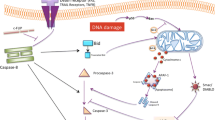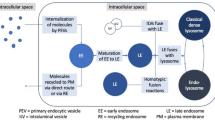Abstract
The involvement of Ras and three major Ras effectors, Raf, phosphatidylinositol 3-kinase (PI3K) and Ral guanine nucleotide exchange factor in the regulation of lysosomal proteases cathepsin L and B in human fibroblasts was compared. We found that cathepsin L cell content was increased by active Ras overexpression through Raf- and PI3K-mediated signaling pathways, while cathepsin B processing was altered by active Ras overexpression. Cathepsin L increased level following active Ras overexpression correlates with an increase of p38 MAPK activation and content and with an increase of p44/42 MAPK activation, so we investigated the role of these signaling pathways using pharmacological inhibitors. Unexpectedly, the p38 MAPK inhibitor SB203580 produced an increase of cathepsin L content, while the p44/42 MAPK signaling cascade inhibitor U0126 produced a remarkable shift of cathepsin L processing in favor of procathepsin L. In both cases, cathepsin B level and processing were not affected. The analysis of CTSL1 gene transcript demonstrated that cathepsin L protein and transcript correlate both in fibroblasts expressing Ras mutants and in pharmacologically treated cells, thus indicating a transcriptional up-regulation.



Similar content being viewed by others
References
Turk B, Turk D, Turk V (2000) Lysosomal cysteine proteases: more than scavengers. Biochim Biophys Acta 1477:98–111
Stoka V, Turk B, Turk V (2005) Lysosomal cysteine proteases: structural features and their role in apoptosis. IUBMB Life 57:347–353
Turk V, Stoka V, Turk D (2008) Cystatins: biochemical and structural properties, and medical relevance. Front Biosci 13:5406–5420
Ishidoh K, Kominami E (1995) Procathepsin L degrades extracellular matrix proteins in the presence of glycosaminoglycans in vitro. Biochem Biophys Res Commun 217:624–631
Maciewicz RA, Etherington DJ, Kos J, Turk V (1987) Collagenolytic cathepsins of rabbit spleen: a kinetic analysis of collagen degradation and inhibition by chicken cystatin. Collagen Relat Res 7:295–304
Yan S, Sameni M, Sloane BF (1998) Cathepsin B and human tumor progression. Biol Chem 379:113–123
Chauhan SS, Goldstein LJ, Gottesman MM (1991) Expression of cathepsin L in human tumors. Cancer Res 51:1478–1481
Lah TT, Kos J (1998) Cysteine proteinases in cancer progression and their clinical relevance for prognosis. Biol Chem 379:125–130
Frade R, Rodrigues-Lima F, Huang S, Xie K, Guillaume N, Bar-Eli M (1998) Procathepsin-L, a proteinase that cleaves human C3 (the third component of complement), confers high tumorigenic and metastatic properties to human melanoma cells. Cancer Res 58:2733–2736
Frade R (1999) Structure and functions of proteases which cleave human C3 and are expressed on normal or tumor human cells: some are involved in tumorigenic and metastatic properties of human melanoma cells. Immunopharmacology 42:39–45
Kirschke H, Eerola R, Hopsu-Havu VK, Bromme D, Vuorio E (2000) Antisense RNA inhibition of cathepsin L expression reduces tumorigenicity of malignant cells. Eur J Cancer 36:787–795
Krueger S, Kellner U, Buehling F, Roessner A (2001) Cathepsin L antisense oligonucleotides in a human osteosarcoma cell line: effects on the invasive phenotype. Cancer Gene Ther 8:522–528
Levicar N, Dewey RA, Daley E, Bates TE, Davies D, Kos J, Pilkington GJ, Lah TT (2003) Selective suppression of cathepsin L by antisense cDNA impairs human brain tumor cell invasion in vitro and promotes apoptosis. Cancer Gene Ther 10:141–151
Jean D, Hermann J, Rodrigues-Lima F, Barel M, Balbo M, Frade R (1995) Identification on melanoma cells of p39, a cysteine proteinase that cleaves C3, the third component of complement: amino-acid-sequence identities with procathepsin L. Biochem J 312(Pt 3):961–969
Ohashi K, Naruto M, Nakaki T, Sano E (2003) Identification of interleukin-8 converting enzyme as cathepsin L. Biochim Biophys Acta 1649:30–39
Ishidoh K, Taniguchi S, Kominami E (1997) Egr family member proteins are involved in the activation of the cathepsin L gene in v-src-transformed cells. Biochem Biophys Res Commun 238:665–669
Poole AR, Tiltman KJ, Recklies AD, Stoker TA (1978) Differences in secretion of the proteinase cathepsin B at the edges of human breast carcinomas and fibroadenomas. Nature 273:545–547
Koblinski JE, Ahram M, Sloane BF (2000) Unraveling the role of proteases in cancer. Clin Chim Acta 291:113–135
Gabrijelcic D, Svetic B, Spaic D, Skrk J, Budihna J, Turk V (1992) Determination of cathepsins B, H, L and kininogen in breast cancer patients. Agents Actions Suppl 38(Pt 2):350–357
Berdowska I (2004) Cysteine proteases as disease markers. Clin Chim Acta 342:41–69
Sloane BF, Moin K, Sameni M, Tait LR, Rozhin J, Ziegler G (1994) Membrane association of cathepsin B can be induced by transfection of human breast epithelial cells with c-Ha-ras oncogene. J Cell Sci 107(Pt 2):373–384
Premzl A, Zavasnik-Bergant V, Turk V, Kos J (2003) Intracellular and extracellular cathepsin B facilitate invasion of MCF-10A neoT cells through reconstituted extracellular matrix in vitro. Exp Cell Res 283:206–214
Bos JL (1989) ras oncogenes in human cancer: a review. Cancer Res 49:4682–4689
Barbacid M (1987) ras genes. Annu Rev Biochem 56:779–827
Shields JM, Pruitt K, McFall A, Shaub A, Der CJ (2000) Understanding Ras: ‘it ain’t over ‘til it’s over’. Trends Cell Biol 10:147–154
Bar-Sagi D, Hall A (2000) Ras and Rho GTPases: a family reunion. Cell 103:227–238
Ramjaun AR, Downward J (2007) Ras and phosphoinositide 3-kinase: partners in development and tumorigenesis. Cell Cycle 6:2902–2905
Rodriguez-Viciana P, Warne PH, Khwaja A, Marte BM, Pappin D, Das P, Waterfield MD, Ridley A, Downward J (1997) Role of phosphoinositide 3-OH kinase in cell transformation and control of the actin cytoskeleton by Ras. Cell 89:457–467
Wolthuis RM, Bos JL (1999) Ras caught in another affair: the exchange factors for Ral. Curr Opin Genet Dev 9:112–117
Hamad NM, Elconin JH, Karnoub AE, Bai W, Rich JN, Abraham RT, Der CJ, Counter CM (2002) Distinct requirements for Ras oncogenesis in human versus mouse cells. Genes Dev 16:2045–2057
Emiliani C, Urbanelli L, Racanicchi L, Orlacchio A, Pelicci G, Sorbi S, Bernardi G (2003) Up-regulation of glycohydrolases in Alzheimer’s disease fibroblasts correlates with Ras activation. J Biol Chem 278:38453–38460
Chambers AF, Colella R, Denhardt DT, Wilson SM (1992) Increased expression of cathepsins L and B and decreased activity of their inhibitors in metastatic, ras-transformed NIH 3T3 cells. Mol Carcinog 5:238–245
Donatien PD, Diment SL, Boissy RE, Orlow SJ (1996) Melanosomal and lysosomal alterations in murine melanocytes following transfection with the v-rasHa oncogene. Int J Cancer 66:557–563
Collette J, Ulku AS, Der CJ, Jones A, Erickson AH (2004) Enhanced cathepsin L expression is mediated by different Ras effector pathways in fibroblasts and epithelial cells. Int J Cancer 112:190–199
White MA, Nicolette C, Minden A, Polverino A, Van Aelst L, Karin M, Wigler MH (1995) Multiple Ras functions can contribute to mammalian cell transformation. Cell 80:533–541
Pearson M, Carbone R, Sebastiani C, Cioce M, Fagioli M, Saito S, Higashimoto Y, Appella E, Minucci S, Pandolfi PP, Pelicci PG (2000) PML regulates p53 acetylation and premature senescence induced by oncogenic Ras. Nature 406:207–210
Bradford MM (1976) A rapid and sensitive method for the quantitation of microgram quantities of protein utilizing the principle of protein–dye binding. Anal Biochem 72:248–254
Rasband WS (1997–2005) ImageJ. US National Institutes of Health, Bethesda, MD, USA. http://rsb.info.nih.gov/ij/
Menard R, Carmona E, Takebe S, Dufour E, Plouffe C, Mason P, Mort JS (1998) Autocatalytic processing of recombinant human procathepsin L. Contribution of both intermolecular and unimolecular events in the processing of procathepsin L in vitro. J Biol Chem 273:4478–4484
Urbanelli L, Emiliani C, Massini C, Persichetti E, Orlacchio A, Pelicci G, Sorbi S, Hasilik A, Bernardi G (2008) Cathepsin D expression is decreased in Alzheimer’s disease fibroblasts. Neurobiol Aging 29:12–22
Hazzalin CA, Cuenda A, Cano E, Cohen P, Mahadevan LC (1997) Effects of the inhibition of p38/RK MAP kinase on induction of five fos and jun genes by diverse stimuli. Oncogene 15:2321–2331
Kalmes A, Deou J, Clowes AW, Daum G (1999) Raf-1 is activated by the p38 mitogen-activated protein kinase inhibitor, SB203580. FEBS Lett 444:71–74
Duncia JV, Santella JB 3rd, Higley CA, Pitts WJ, Wityak J, Frietze WE, Rankin FW, Sun JH, Earl RA, Tabaka AC, Teleha CA, Blom KF, Favata MF, Manos EJ, Daulerio AJ, Stradley DA, Horiuchi K, Copeland RA, Scherle PA, Trzaskos JM, Magolda RL, Trainor GL, Wexler RR, Hobbs FW, Olson RE (1998) MEK inhibitors: the chemistry and biological activity of U0126, its analogs, and cyclization products. Bioorg Med Chem Lett 8:2839–2844
Kos J, Lah TT (1998) Cysteine proteinases and their endogenous inhibitors: target proteins for prognosis, diagnosis and therapy in cancer (review). Oncol Rep 5:1349–1361
Mohamed MM, Sloane BF (2006) Cysteine cathepsins: multifunctional enzymes in cancer. Nat Rev Cancer 6:764–775
Goulet B, Baruch A, Moon NS, Poirier M, Sansregret LL, Erickson A, Bogyo M, Nepveu A (2004) A cathepsin L isoform that is devoid of a signal peptide localizes to the nucleus in S phase and processes the CDP/Cux transcription factor. Mol Cell 14:207–219
Goulet B, Sansregret L, Leduy L, Bogyo M, Weber E, Chauhan SS, Nepveu A (2007) Increased expression and activity of nuclear cathepsin L in cancer cells suggests a novel mechanism of cell transformation. Mol Cancer Res 5:899–907
Jean D, Guillaume N, Frade R (2002) Characterization of human cathepsin L promoter and identification of binding sites for NF-Y, Sp1 and Sp3 that are essential for its activity. Biochem J 361:173–184
Jean D, Rousselet N, Frade R (2006) Expression of cathepsin L in human tumor cells is under the control of distinct regulatory mechanisms. Oncogene 25:1474–1484
Jean D, Rousselet N, Frade R (2008) Cathepsin L expression is up-regulated by hypoxia in human melanoma cells: role of its 5′-untranslated region. Biochem J 413:125–134
Collette J, Bocock JP, Ahn K, Chapman RL, Godbold G, Yeyeodu S, Erickson AH (2004) Biosynthesis and alternate targeting of the lysosomal cysteine protease cathepsin L. Int Rev Cytol 241:1–51
Bublil EM, Yarden Y (2007) The EGF receptor family: spearheading a merger of signaling and therapeutics. Curr Opin Cell Biol 19:124–134
Raingeaud J, Gupta S, Rogers JS, Dickens M, Han J, Ulevitch RJ, Davis RJ (1995) Pro-inflammatory cytokines and environmental stress cause p38 mitogen-activated protein kinase activation by dual phosphorylation on tyrosine and threonine. J Biol Chem 270:7420–7426
Acknowledgements
This work was supported by COFIN-PRIN, FIRB from “Ministero dell’Istruzione, Università e Ricerca” (Italy) and “Fondazione Cassa di Risparmio di Perugia” (2008.021.375) grants to C.E. Authors disclose any actual or potential conflicts of interest including any financial, personal or other relationships with other people or organizations within 3 years of beginning the work submitted that could inappropriately influence their work.
Author information
Authors and Affiliations
Corresponding author
Rights and permissions
About this article
Cite this article
Urbanelli, L., Trivelli, F., Ercolani, L. et al. Cathepsin L increased level upon Ras mutants expression: the role of p38 and p44/42 MAPK signaling pathways. Mol Cell Biochem 343, 49–57 (2010). https://doi.org/10.1007/s11010-010-0497-3
Received:
Accepted:
Published:
Issue Date:
DOI: https://doi.org/10.1007/s11010-010-0497-3




